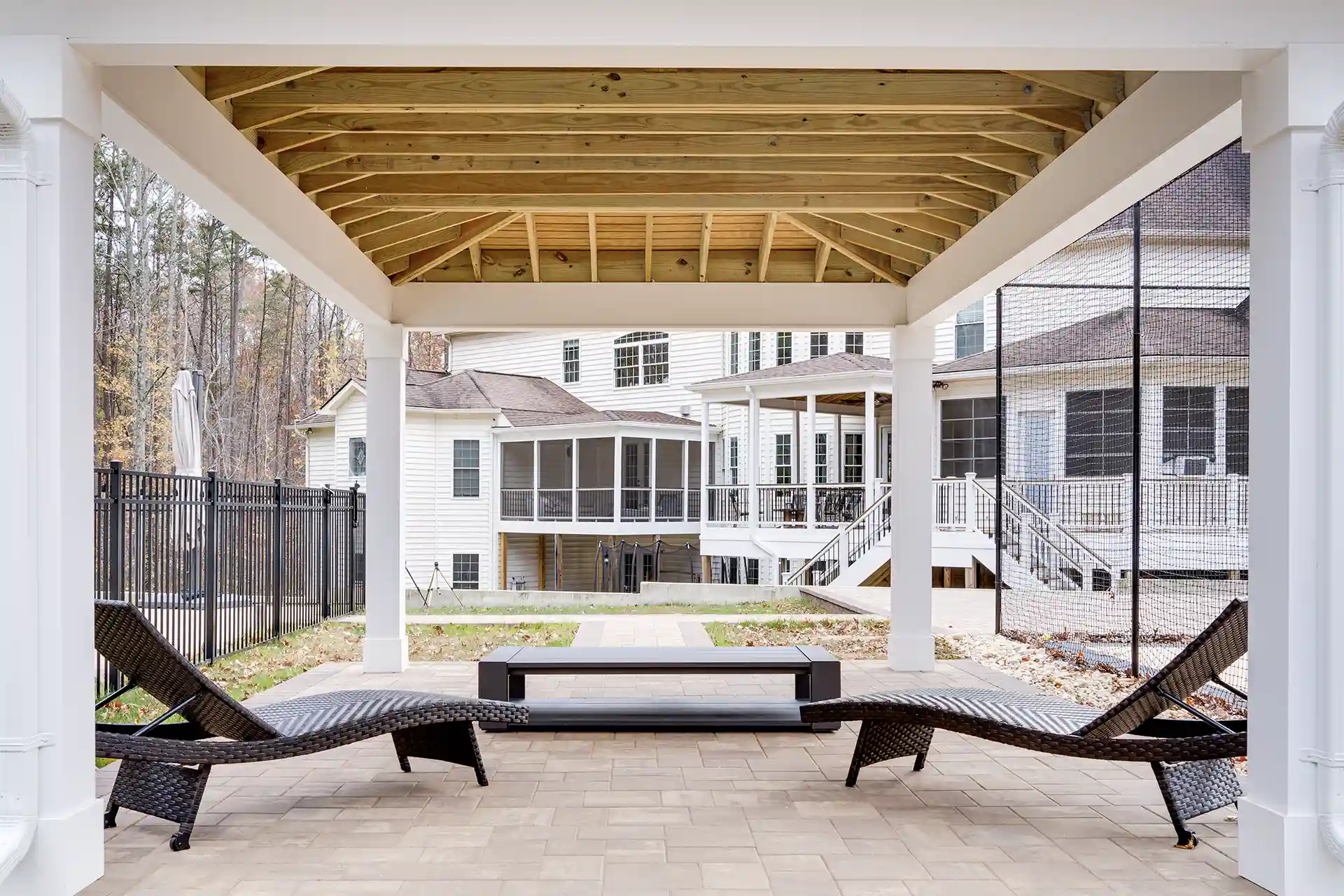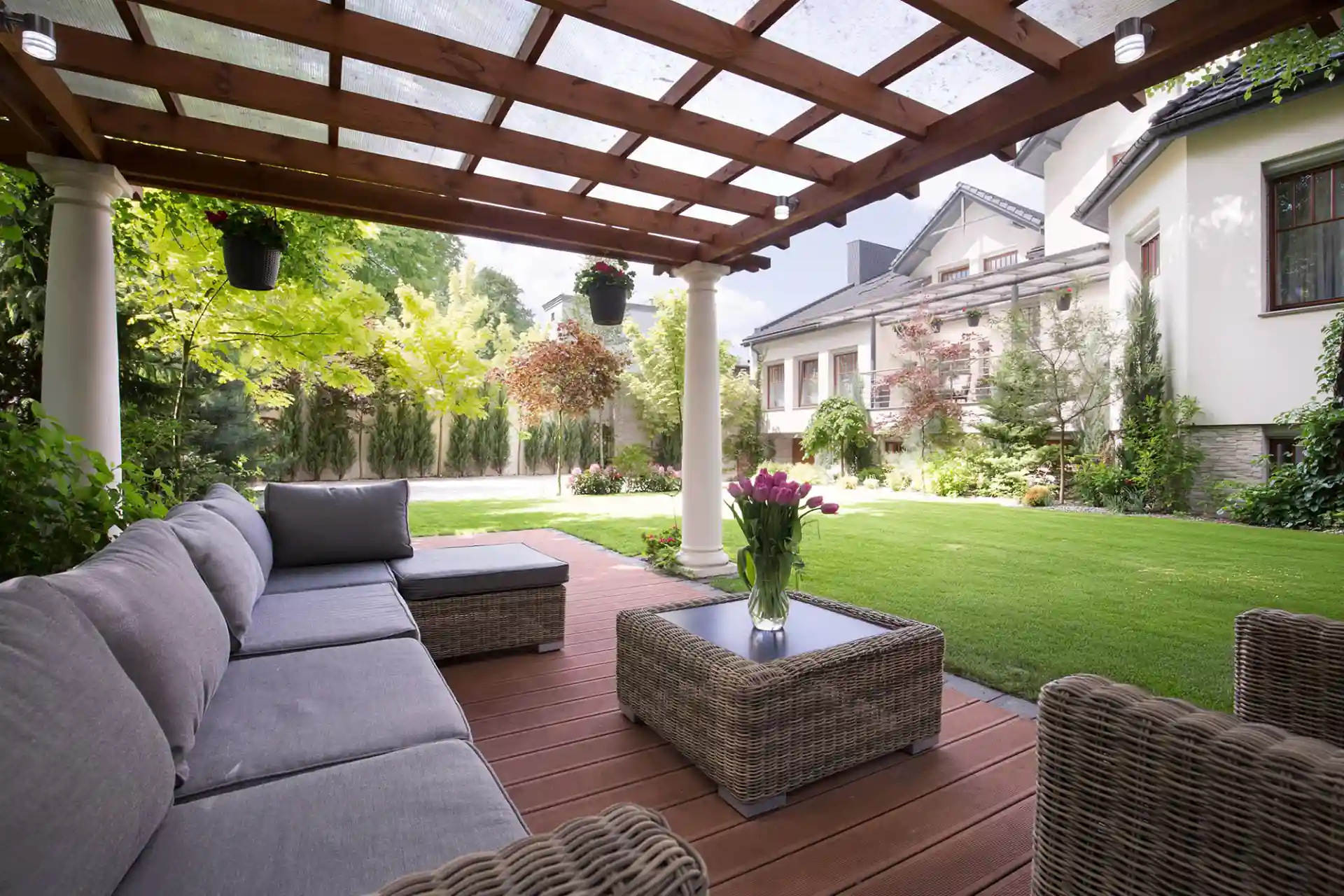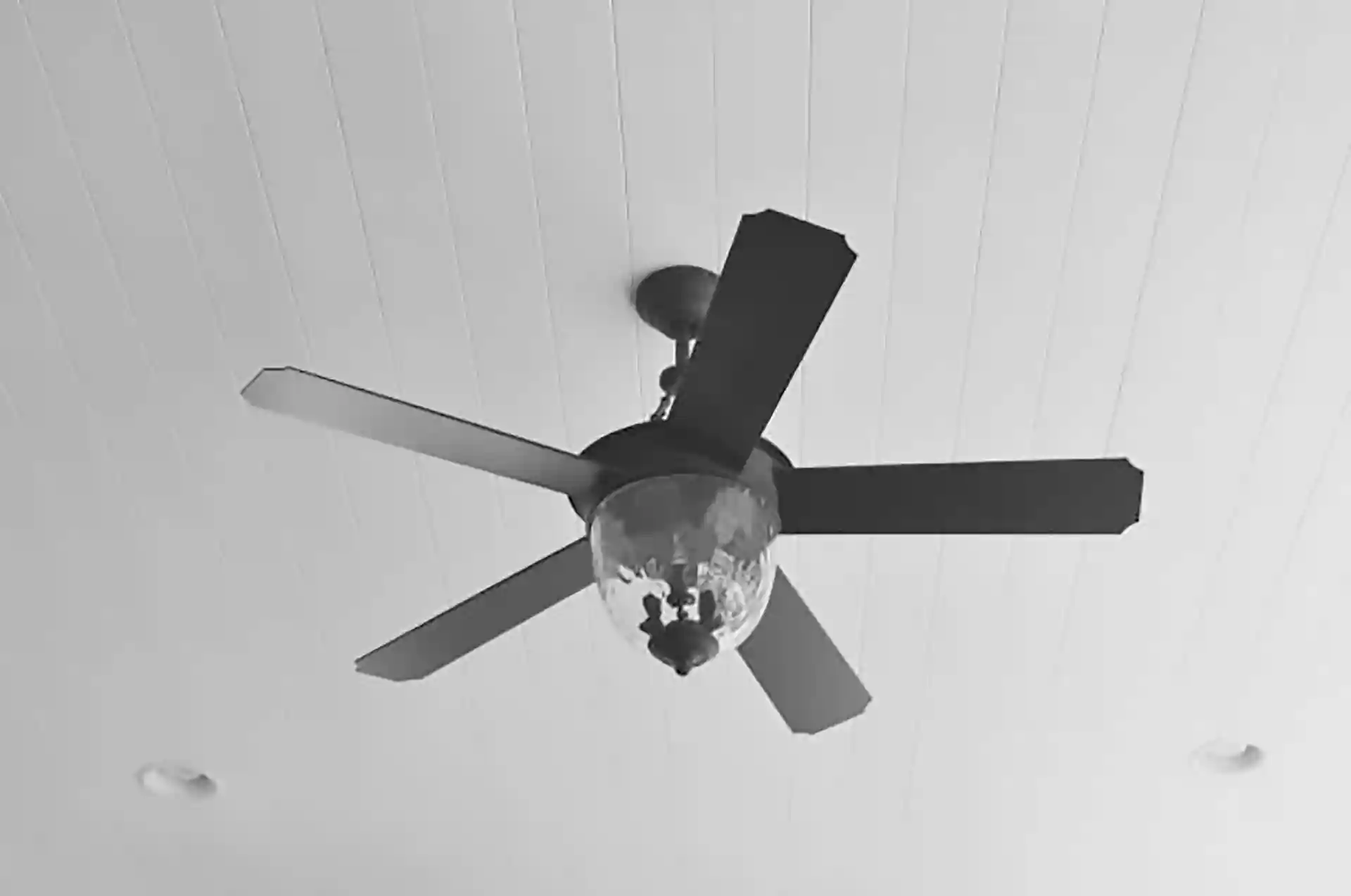Your patio should be a relaxing retreat, not a heat trap. With the right shade structures, materials, and airflow solutions, you can learn how to keep your patio cool in summer, even on the hottest days. Whether you have a concrete slab or a custom deck, there are several practical ways to combat the heat.
Here are five ways to cover your patio for cooler outdoor living, along with 24 additional ideas to keep your space comfortable throughout the season.
Why Does Your Patio Get Hot?
To understand how to keep your patio cool in summer, it’s important to address the factors that cause patios to heat up, such as poor airflow and a lack of shade structures.
Patios heat up for several reasons. Let’s break down why this happens:
- Heat Absorption from Surface Materials: Concrete, stone, and pavers absorb heat during the day and release it slowly at night, making your patio feel hotter in the evening. Choosing materials with low thermal mass and reflective coatings is a key factor in keeping your patio cool in summer.
- Lack of Overhead Protection: When considering how to keep your patio cool in summer, installing a patio cover can make a huge difference in blocking sunlight and providing shade. A patio exposed to full sun can reach up to 130–150°F.
- Patio Orientation: The direction your patio faces matters. South-facing patios get sunlight all day, while west-facing patios experience the most intense afternoon heat. Without shade structures like pergolas or patio covers, the heat builds up quickly.
- Radiant Reflection from Nearby Structures: Walls, fences, and dark-colored exterior surfaces reflect additional heat onto your patio, intensifying the warmth.
- Poor Airflow: Still air traps heat. If walls surround your patio or lack ventilation, it creates a heat bubble that makes the space feel stagnant and uncomfortable.
Materials That Help Keep Patios Cool in Summer
Patio surfaces absorb a significant amount of heat during the day, especially concrete, stone, and other hardscapes. To reduce heat buildup and make your outdoor space more comfortable, choose materials and coatings that reflect sunlight, minimize surface temperatures, and reduce thermal mass. Here’s how:
1. High-Albedo Concrete Sealers and Paints
These are special sealers or coatings designed for concrete that reflect sunlight and reduce heat absorption.
- Why It Works: High-albedo sealers and reflective coatings for concrete reflect UV rays, reducing heat absorption. Products like Tropi-Cool, designed for roofs but also effective for patios, help keep the surface cooler.
- Key Benefit: Reflects sunlight, reduces surface temperature by up to 30°F.
2. Light-Toned Tile or Paver Surfaces with Low Thermal Mass
These are tiles or pavers in light tones, such as ivory, pale gray, or light sand, designed to reduce heat retention on your patio.
- Why It Works: Materials with high thermal mass, such as dark flagstone or brick, retain heat long after the sun sets. Light-toned porcelain pavers, like ivory, light sand, or pale gray, absorb significantly less heat.
- Key Benefit: Reduced heat retention, ensuring your patio remains cooler.
3. Permeable Surface Systems That Breathe
Permeable paving systems, such as Gravel-Grass Hybrid Grids and Porous Concrete, allow water and air to flow through, preventing heat buildup.
- Why It Works: Permeable paving systems, such as Gravel-Grass Hybrid Grids and Porous Concrete, allow water and air to pass through, reducing surface temperatures. These materials also support healthier landscaping.
- Key Benefit: Improves airflow, reduces heat buildup, and supports water permeability.
4. Advanced Deck Boards with Heat-Reducing Technology
Composite decking materials, like MoistureShield CoolDeck® and Deckorators Voyage, are designed to absorb less heat.
- Why It Works: Modern composite decking products, such as MoistureShield CoolDeck® and Deckorators Voyage, absorb less heat. CoolDeck® absorbs up to 35% less heat than traditional capped composites, making it ideal for sunny decks.
- Key Benefit: Reduces heat absorption by up to 35%, providing a cooler deck surface.
5. Concrete with Titanium Dioxide
A concrete mix that includes titanium dioxide, a compound that reflects UV rays and helps reduce heat absorption.
- Why It Works: Some newer concrete mixes incorporate titanium dioxide, which reflects UV rays and helps break down surface pollutants. This material is commonly used in city paving projects but can also be applied to patios.
- Key Benefit: Reflects UV rays, reducing heat absorption and maintaining a cooler surface.
5 Ways to Cover Your Patio and Keep It Cool
If your patio gets too hot in summer, covering it can help reduce heat and improve comfort. By using the right materials and structures, you can block sunlight, allow airflow, and create a cooler outdoor space. Here are five practical ways to cover your patio and beat the heat.
1. Install a Pergola or Covered Deck with Adjustable Louvers
Pergolas with adjustable louvered roofs allow you to control the amount of sunlight that filters through, providing both shade and ventilation.
- Why It Works: A pergola blocks direct sunlight from reaching the patio, reducing heat buildup on surfaces. The open design allows air to circulate, preventing the area from overheating. Adjustable louvers allow for flexible control of shade throughout the day.
- Key Benefit: Provides shade while promoting airflow, helping to reduce heat and maintain comfort.
2. Use Shade Sails for Flexible Coverage
Shade sails are UV-resistant fabric structures that can be mounted at different angles. These sails can be adjusted to block as much or as little sunlight as you need.
- Why It Works: Shade sails block up to 95% of UV rays, lowering the temperature on your patio. The fabric allows air to pass through, which prevents heat from building up underneath. The adjustable nature allows you to reposition the shade according to the sun’s position.
- Key Benefit: Offers customizable shade for different parts of the patio, with flexibility to adjust as the sun moves.
3. Opt for Retractable Awnings for Sun Control
These motorized or manual systems extend and retract according to your preferences.
- Why It Works: Retractable awnings use UV-resistant fabric to block sunlight. When extended, they create a full canopy of shade, lowering the temperature by preventing sunlight from hitting the patio surfaces. When retracted, you can enjoy full sun.
- Key Benefit: Provides immediate shade when needed and can be retracted to allow sunlight for outdoor activities.
4. Apply Reflective Roof Coatings to Your Existing Patio Roof
Made from elastomeric materials, reflect UV rays and prevent the roof from absorbing heat.
- Why It Works: Reflective coatings lower the roof’s thermal mass, reducing the amount of heat absorbed during the day. This helps keep the patio cooler by preventing heat from radiating back down onto the space below.
- Key Benefit: Reflective coatings can reduce roof temperature by up to 30°F, keeping the patio cooler even in full sunlight.
5. Incorporate Shade Trees and Climbing Vines
Natural solutions that offer long-term shade and cooling benefits. Trees like Japanese maples or crepe myrtles offer lasting shade, while vines can be trained over structures like pergolas.
- Why It Works: Shade trees absorb sunlight and release moisture through transpiration, which cools the surrounding air. Vines on trellises or pergolas add extra shade, reducing direct sunlight and improving cooling.
- Key Benefit: Provides sustainable shade and natural cooling while improving the aesthetic of your outdoor space.
Additional Cooling Solutions: 24 Ideas to Keep Your Patio Cool in Summer
The right combination of shade, airflow, and materials can transform your patio into a cool, inviting space all summer long.
Here are 24 practical ideas to keep your patio cool:
Shade Solutions
| Idea | Description | Key Features |
| Retractable Awning | Adjustable, UV-resistant fabric that blocks up to 99% of UV rays. | Flexible shade, energy-efficient, easy to install |
| Pergola with Adjustable Louvers | Pergola with louvers to control sunlight exposure. | Customizable sunshade enhances patio style |
| Shade Sail Canopy | Flexible fabric structure providing adjustable shade. | UV-blocking, adjustable, modern design |
Airflow Solutions
Consider these solutions to boost natural ventilation:
| Idea | Description | Key Features |
| Solar-Powered Fans | Solar-powered fans prevent heat buildup and enhance natural cooling. | Eco-friendly, energy-efficient, no electricity cost |
| Outdoor Misting System | Misting systems spray fine water droplets to cool the air. | Reduces temperature by 10–20°F, effective in dry climates |
| Cross-Ventilation | Design your patio layout to allow natural airflow, promoting cooling. | No mechanical systems, enhances comfort naturally |
Landscaping & Greenery
Incorporating plants and greenery provides natural cooling benefits:
| Idea | Description | Key Features |
| Vertical Gardens & Green Walls | Vertical gardens that absorb sunlight, release moisture, and cool the air. | Green aesthetics reduce ambient temperature |
| Shade Trees | Trees like Japanese maples or crepe myrtles provide natural shade. | Long-term shading enhances the landscape |
| Ground Cover Plants | Low-maintenance plants like clover or sweet alyssum help cool the surface. | Reduces surface heat retention |
Water-Based Cooling
Water features can cool the air and add a calming aesthetic to your patio:
| Idea | Description | Key Features |
| Water Feature (Fountain/Waterfall) | Fountains or waterfalls cool the air through evaporation. | Natural cooling effect, aesthetic, tranquil sound |
| Evaporative Cooling System | Misting systems or sprinklers release water vapor to cool the air. | Low-maintenance, fast cooling effect |
Lighting and Ambience
Lighting solutions can lower the perceived temperature while improving the ambiance of your outdoor space:
| Idea | Description | Key Features |
| Outdoor LED Lighting | LED lights that lower the perceived temperature by illuminating without adding heat. | Energy-efficient, long-lasting, aesthetic |
| Solar-Powered Outdoor Lights | Solar-powered lights provide ambient lighting without the use of electricity. | Eco-friendly, low-maintenance |
Pergolas & Covered Decks
Adding pergolas or mesh-covered decks can provide shade while maintaining airflow:
| Idea | Description | Key Features |
| Pergola with Vines | Install climbing vines for additional shade and natural cooling. | Natural shade improves privacy and aesthetics |
| Covered Decks with Mesh Screens | Mesh screens are added to covered decks to block UV rays while allowing airflow. | Blocks UV rays, promotes airflow. |
Additional Cooling Ideas
Here are more ways to keep your patio cool:
| Idea | Description | Key Features |
| Install Reflective Roof Coatings | Apply reflective coatings to the patio roof to reduce heat absorption. | Reflects sunlight, reduces surface temperatures |
| Frosted Window Film | Apply frosted window film on windows to reduce heat entering from the sun. | UV-blocking reduces indoor temperature |
| Add Pergola Curtains | Install curtains around your pergola for adjustable shade and privacy. | Adjustable, provides privacy, reduces heat |
| Use Heat-Absorbing Gravel | Use light-colored gravel in landscaping to absorb heat while maintaining a cooler surface. | Low-maintenance, cooler surfaces |
Long-Term Solutions
Invest in solutions that provide long-term temperature regulation for your patio:
| Idea | Description | Key Features |
| Install Green Roofs | Green roofs offer insulation and cooling while protecting the patio. | Insulating, eco-friendly |
| Use Cool-Color Paint for Decks | Paint your deck or fence with heat-reflective paint to reduce heat absorption. | Reflective, extends deck lifespan |
Additional Cooling Solutions
For those looking to take their cooling efforts a step further:
| Idea | Description | Key Features |
| Outdoor Ceiling Fan with Lights | Install a ceiling fan with lights to cool the air while providing light. | Dual functionality, energy-efficient |
| Install Air Curtains | Use air curtains to prevent heat from entering patio doors and maintain airflow. | Easy to install, reduces heat infiltration |
Water-Based Cooling
Adding water-absorbing materials can help regulate temperature for longer:
| Idea | Description | Key Features |
| Water-Absorbing Stones | Use water-absorbing stones around the patio to keep the surface cooler longer. | Long-lasting, natural cooling effect |
Weatherproof Your Patio
Protecting your patio from the elements ensures it stays in great shape. Here’s how to do it:
- Install Durable Shade Structures
Use retractable awnings, shade sails, or a pergola to protect your patio from rain and sun. These will keep your space cooler and prevent damage to furniture and flooring. - Apply Waterproof Deck Sealants
Coat your deck with waterproof sealants to prevent damage from rain and moisture. This helps protect the wood from rot and keeps the surface intact. - Add Reflective Roof Coatings
For covered patios, use reflective roof coatings to reduce heat buildup and protect the roof from weather-related damage, thereby extending its lifespan. - Choose Low-Maintenance Composite Decking
Composite decking resists weathering and moisture so that it won’t warp or fade. Select materials like MoistureShield CoolDeck to keep your deck cool and durable. - Install a Green Roof
A green roof adds insulation and helps protect your patio from temperature changes. It also provides shade, keeping your space cool in summer.
By selecting the right materials and solutions, you can create a cooler and more comfortable patio. Whether you’re installing shade structures, using heat-resistant decking, or adding plants for natural cooling, there are many ways to reduce the heat.
Ready to start your patio transformation? Contact Prince William Home Improvement today for expert deck construction, patio upgrades, and weatherproofing solutions. Let us help you create a space you’ll enjoy all summer long.
FAQs
How to cool a hot patio?
Consider installing shade structures, such as pergolas, retractable awnings, or shade sails. For continuous airflow, add solar-powered fans that circulate air and provide natural cooling.
Additionally, applying reflective coatings on your patio roof or patio surfaces, such as cool roof coatings, can reduce heat absorption by reflecting UV rays, further lowering the surface temperature and making your patio more comfortable.
How to make a concrete patio less hot?
- Apply high-albedo sealers: Use high-albedo sealers or reflective coatings to reflect UV rays and reduce heat absorption.
- Install light-colored tiles or pavers: Light-colored tiles or porcelain pavers reduce heat retention compared to darker concrete.
- Use permeable paving: Allows air and water to flow through, decreasing the thermal mass and keeping the patio cooler.
To keep your patio cool in summer, try incorporating these materials and techniques. By using heat-reflective materials and improving airflow, you will notice a significant reduction in the heat retained by your concrete patio.
How to reduce outdoor heat?
- Plant shade trees: Trees like Japanese maples and crepe myrtles provide long-lasting shade and cool the air through transpiration.
- Install misting systems: Misting systems or sprinklers cool the air through evaporative cooling, lowering outdoor temperatures.
- Use permeable paving: Install gravel-grass grids or porous concrete to allow air and water to flow through, reducing heat buildup.
- Incorporate greenery: Add vertical gardens or ground cover plants like clover to reduce surface heat retention and provide shade..
What can you put on concrete to keep it from getting hot?
- Reflective coatings: Apply cool roof coatings or high-albedo concrete sealers to reduce heat absorption and increase energy efficiency. These coatings reflect UV rays and can lower surface temperatures by up to 30°F.
- Light-colored tiles or pavers: Lighter surfaces reflect more sunlight and absorb less heat, preventing the concrete from getting too hot.
- Permeable paving systems: Install permeable pavers or gravel-grass grids that allow air and water to flow through. This reduces heat buildup and prevents the “hot plate” effect found in solid, sealed surfaces.
- Concrete with titanium dioxide: Helps reflect UV rays and break down surface pollutants. This material reduces heat absorption, making it an excellent option for reflective outdoor surfaces.
- Patios: Consider adding a patio roof or patio cover to shield your concrete patio from direct sunlight.





